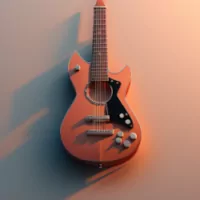Blues music is one genre that has fully embraced the possibilities of the electric guitar, an instrument that has become recognizable in the world of music. With its deep melodies and expressive guitar playing, the blues subgenre known as electric blues has won the hearts of millions of listeners and played a significant part in defining the landscape of current guitar playing.
The origins of electric blues can be found in the early 20th century when African Americans in the South of the United States began to become fans of the blues genre, which is distinguished by its 12-bar chord progression and sentimental lyrics. Acoustic instruments were typically used to play the blues back then, but the introduction of electric guitars and amplifiers in the 1930s and 1940s would forever alter the genre.
T-Bone Walker, B.B. King, and Muddy Waters were among the first musicians to use an amplified sound, as were other early practitioners of electric blues. They were able to perform for larger crowds in clubs and theaters thanks to the louder, more expressive tone they were able to generate by connecting their guitars to amplifiers. The music was made more approachable by this electrification, which also added a new dimension of emotion and power to the blues.
Learn to Play the Guitar
Characteristics
Vibrato and Bending: The heavy use of vibrato and bending in electric blues guitar playing is one of its distinguishing characteristics. These methods enable guitarists to add expressiveness to their notes, mimicking the human voice and expressing a variety of emotions. While bending comprises pressing or tugging a string to raise or reduce its pitch, vibrato involves vibrating a note’s pitch.
Electric blues frequently uses the call-and-response structure, in which the guitar “calls” with a melodic line, and another instrument—typically the guitar—responds. It is a stimulating experience for both artists and listeners since this interactive method improves the dynamic and improvisational quality of the genre.
Blues Scale and Phrasing: Electric blues guitarists frequently use the blues scale, a six-note scale made up of the major scale’s root, flat third, fourth, flat fifth, fifth, and flat seventh degrees. In addition to providing a distinctive bluesy tone, the blues scale provides a solid framework for improvisational phrasing.
Slides, Hammer-ons, and Pull-offs: These three guitar-playing methods help to make electric blues guitar playing fluid and seamless. While hammer-ons and pull-offs provide quick transitions between notes, slides involve gliding from one note to the next. These techniques allow guitarists to add flair and dexterity to their solos.
Effects pedals are a common tool used by electric blues guitarists to further sculpt their sound. They frequently use reverb, delay, and overdrive/distortion to produce a rich and distinctive tone that gives their playing depth and texture.
Electric blues guitar playing has had a significant influence on numerous musical genres and later generations of musicians. Eric Clapton, Jimi Hendrix, and Stevie Ray Vaughan were among the guitar greats who led the 1960s blues-rock movement, which combined blues and rock components and ushered in a new age of spectacular guitar performances.
Additionally, the impact of electric blues goes beyond just rock music. Guitarists in modern jazz, country, and even metal genres frequently borrow blues phrasing and methods for their compositions.
In the realm of music, electric blues guitar performance has had an enduring impression. Its evocative and passionate features, along with its technical virtuosity, have elevated it to a genre that is beloved by music lovers around. The electric guitar never fails to enthrall audiences and capture the very essence of the human soul, whether it’s through the wailing notes of an intense solo or the rhythmic groove of a blues progression. The essence of electric blues will always reverberate throughout the history of music as long as there are guitarists eager to put their all into their instrument.
Image by master1305 on Freepik

